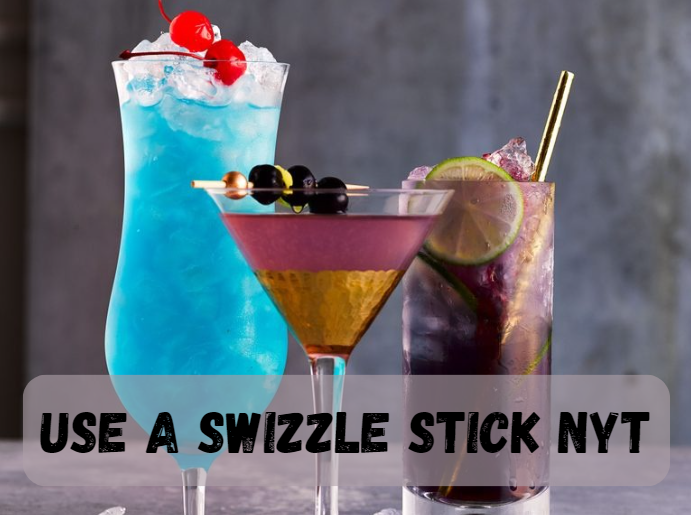Puzzle fans have always been enthralled with crossword puzzles because they provide clues that frequently allude to a wide range of subjects, from pop culture to literature. “use a swizzle stick nyt” is one such clue that has drawn notice; it was last spotted in The New York Times fast crossword. Although the crossword clue appears straightforward at first, its interpretation provides insight into the complex history of cocktail culture as well as puzzle-solving strategies.
This article will examine the meaning of the term “use a swizzle stick,” examine how important it is in crossword puzzles, and examine the swizzle stick in more detail. We hope that our in-depth examination will improve your knowledge and appreciation of crossword puzzles as well as the special role that swizzle sticks play in American society.
Importance of Swizzle Sticks in History
Despite its seemingly simple appearance, the swizzle stick has an unexpectedly lengthy history. This equipment, which comes from the Caribbean, was initially employed to make the “swizzle,” a customary drink there. Cocktails called swizzles are produced with rum, lime, and other components. To get the ideal flavor combination, the contents are briskly mixed with a swizzle stick. The swizzle stick originated in the West Indies, where a local tree branch was used to construct it. The early models were frequently constructed of wood, to be both long-lasting and efficient in producing well-mixed, foamy drinks.
With the rise in popularity of swizzle sticks, they were used in homes and bars all over the world, but especially in the United States in the middle of the 20th century when cocktails became the focal point of social events. Swizzle sticks eventually changed from being straightforward wooden implements to elaborate, frequently plastic creations that were sold as components of cocktail sets. Cocktail culture took notice of the swizzle stick when several establishments began to manufacture customized swizzle sticks with their logos on them. The swizzle stick gained prominence as a symbol of refinement and leisure during its heyday in American cocktail culture. It was typically associated with tiki clubs and exotic drinks during the mid-1900s, which associated it with ideas of glitz and escape.
The Answer to the Crossword Clue!
It makes use of a swizzle stick. The crossword clue NYT usually has a four-letter solution. Asking for an action to be done with a swizzle stick is the clue in this case. STIR is the solution to this puzzle. Using a swizzle stick requires you to thoroughly mix the drink by stirring it. By doing this, you can be sure that every ingredient in the drink is mixed perfectly. Since “stir” is a straightforward and widely used term for this procedure, it meets the description exactly. Comprehending such simple hints can simplify and increase the fun of solving crossword puzzles.
A Contemporary Resurrection of the Swizzle Stick
These days, swizzle sticks are making a comeback. The practical applications of the swizzle stick in crafting the ideal cocktail are being rediscovered by contemporary bartenders. Who is committed to the art and science of mixology? For environmental concerns, many bars now use metal swizzle sticks. But the swizzling procedure is still an important part of making cocktails.
Conversations concerning sustainable bartending techniques have also been triggered by the resurgence of interest in swizzle sticks. Reusable or biodegradable swizzle sticks have become more popular than single-use plastic ones as environmentally concerned consumers become more prevalent. Cocktail tools have evolved as a result of this environmental consciousness. It is enabling bartenders to strike a balance between sustainability and usability.
Examining Crossword Puzzles: The Significance of Hints Such as “Apply a Swizzle Stick NYT”
Crossword puzzles are a cerebral workout that forces the brain to think creatively, so they’re much more than just a hobby. In particular, the New York Times crossword is renowned for its intricacy and deft wordplay. When a hint like “use a swizzle stick” is presented to solvers, they have to consider it from several angles.
Word and phrase meanings in the NYT crossword frequently need solvers to take into account both their literal and colloquial interpretations. For instance, “use a swizzle stick” could refer to literally “stir,” or it could have a more figurative meaning that has to do with combining ingredients creatively or symbolically.
Proficient crossword solvers typically possess a large vocabulary and knowledge of a wide range of subjects, including science, history, popular culture, and even mixology. But deciphering the subliminal hints buried in the language is frequently the key to solving riddles. The purpose of clues such as “use a swizzle stick” is to have solvers go beyond the obvious and look for links between the clue and possible solutions.
Tips for Solving Crossword Puzzles
Consider Alternative Interpretations: Crossword puzzle clues frequently use wordplay or ambiguity. Don’t limit yourself to the term that first springs to mind; take into account idioms, metaphors, and other meanings.
Seek Out Trends: Crossword clues can occasionally be written in a way that makes the type of solution obvious. Take note of the answer’s length, the clue’s tense, and any further linguistic cues.
Think About the Subject: There are themes in many crossword puzzles that direct the solutions. For instance, if the problem has a cocktail theme, then clues like “use a swizzle stick” are probably related to mixing drinks.
Utilise Reference Materials: Having a reference manual handy for new terms is beneficial while figuring out crossword puzzles. A mixology handbook or cocktail recipe book could supply you with the answers you need for any clues about cocktails.
Cocktail Culture and Swizzling Techniques
Beyond crossword puzzles, the swizzle stick is an essential component of cocktail culture, representing both innovation and tradition. When making some kinds of beverages, especially tropical and rum-based cocktails, the art of swizzling is a crucial technique. Swizzling is a novel technique for giving drinks a light, frothy texture, even though shaking and stirring are the more popular ways to mix drinks.
To swizzle, insert the swizzle stick into the glass and quickly roll it between your palms to mix the ingredients. This results in a subtle mingling of the flavors without overstirring the drink. In layered cocktails, swizzling is very helpful since it disperses the contents uniformly without rupturing the layers.
A popular Trinidadian cocktail made with rum, lime, mint, and sugar, the Queen’s Park Swizzle is one of the most well-known drinks that must be swizzled. This drink is a perfect example of how the swizzling technique can achieve a balance of flavors.
The swizzle stick is still prized in today’s artisan cocktail scene for its capacity to produce complicated concoctions. The swizzle stick is a representation of accuracy and attention in cocktail making, whether it is utilized in classic tiki drinks or contemporary creations.
Conclusion
There is considerably more to the expression “use a swizzle stick” than first meets the eye. Crossword puzzle solvers are forced to use their imaginations and make links between drinking culture and the mental acrobatics needed to finish a puzzle.
The swizzle stick, which has its origins in Caribbean culture, is still a crucial component in contemporary cocktail creation and is a representation of skill and elegance. Wordplay and mixology are joyful endeavours, and the swizzle stick reminds you of this whether you’re making the ideal drink or cracking a crossword.
We have examined the swizzle stick’s extensive cultural effect on American society as well as other cultures by delving deeply into the stick’s history and significance. Knowing the complete meaning of “use a swizzle stick” enhances the enjoyment of both crossword puzzles and cocktail recipes.



